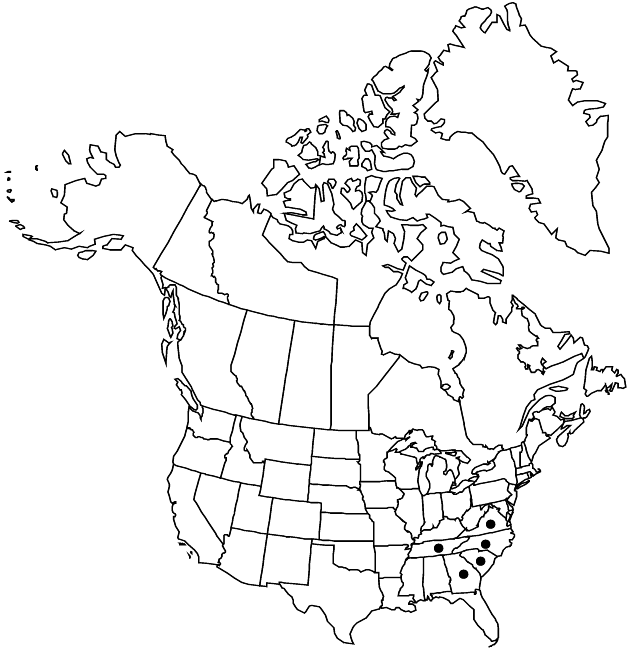Eurybia chlorolepis
Phytologia 77: 259. 1995.
Plants 25–80 cm; forming ± dense clones (lacking sterile rosettes); rhizomes elongate, thin, woody with age. Stems 1, erect, simple, flexuous, proximally glabrous or villous, more densely villous distally. Leaves basal and cauline, thin, margins ± sharply serrate, teeth (6–20 per side) mucronulate, strigoso-ciliate, apices acuminate, abaxial faces glabrous or sparsely villous, adaxial sparsely strigose, long-stipitate-glandular (black) along veins; basal and proximal cauline withering by flowering, long-petiolate, blades widely ovate, basal smaller than proximal, bases cordate to subcordate (sinuses narrow); cauline long (10–50 mm) petiolate, wingless or increasingly winged distally, blades ovate, 30–110 × 11–64 mm, bases cordate (proximal) to rounded or rounded-cuneate (distal); distal (arrays) sessile or short (0–11 mm), widely-winged petiolate, blades ovate, 8–38 × 5–23 mm. Heads 3–25+ in open, corymbiform arrays. Peduncles (subtended by ± reduced distal leaves, longest more than 1.5 cm) villous, eglandular; bracts 0(–1), abruptly smaller than leaves, 2–2.5 × 1–1.5 mm, sometimes subtending heads. Involucres campanulate, 6.5–9(–10) mm, shorter than pappi. Phyllaries ca. 27 in 4–5 series, ovate or oblong (outer) to oblong-lanceolate or lanceolate (inner), strongly unequal, membranous, bases indurate, pale green zones on less than distal 1/4 (outer, a few sometimes more than 1/2) to 1/6 or none (inner), margins not scarious, entire or slightly erose, often purplish distally (inner), densely villoso-ciliate, apices obtuse to acute, abaxial faces glabrous or sparsely villous, eglandular. Ray florets (8–)12–16(–20); corollas usually white, sometimes lilac-tinged, (10–)17–18(–20) × 2.6–3.3 mm. Disc florets (12–)17–26; corollas yellow, 5.6–6.1 mm, abruptly ampliate, tubes (3–3.6 mm) longer than campanulate throats (0.7–1.1 mm), lobes reflexed, lanceolate, 1.5–2 mm. Cypselae tan to brown, fusiform to cylindro-obovoid, slightly compressed, 3.3–3.5 mm, ribs 7–10, stramineous, faces glabrate to sparsely strigillose; pappi of pale cinnamon (fine, barbellulate) bristles 6.2–6.3 mm, equaling to longer than disc florets. 2n = 36, 45.
Phenology: Flowering late summer–fall.
Habitat: High elevation Appalachian red spruce–Fraser fir and cool mixed forests
Elevation: 1200–2000 m
Distribution

Ga., N.C., S.C., Tenn., Va.
Discussion
Eurybia chlorolepis is known only from the Blue Ridge physiographic province. It is possibly extirpated at the southern end of its range in Georgia, South Carolina, and Tennessee, and it is vulnerable elsewhere. It was mapped by W. F. Lamboy (1992), who showed its distinctness from E. divaricata using morphometric and cytologic data.
Selected References
None.